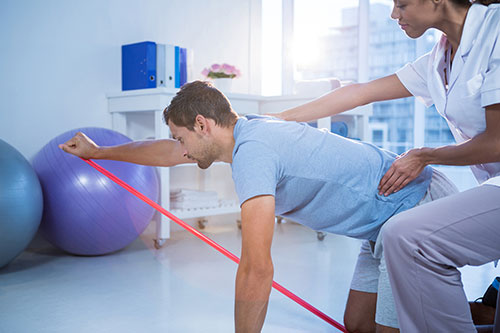Lower Back Physio
Back pain is one of the most common pain that people worldwide suffer, in many cases this pain prevents ordinary life activities as simple as walking. For this reason, people who have any pain in any area of the back should pay attention, because although at first does not seem serious, it can become a problem that affects the quality of life in the long term.
In addition to the classic medical treatments there is a large number of physical therapies that physiotherapists can apply as lower back physiotherapy treatment, with the added advantage that no iatrogenic effects occur.

What is lower back pain?
Lower back pain also known as lumbago is a medical term used to define pain in the lower or lower back where the lumbar vertebrae are located.
The main cause of low back pain in young people is muscle overstretching, repetitive movements or direct impact on the lower back. In the third age, osteoarthritis and osteoporosis are the main responsible for the appearance of lumbar discomfort. There are multiple causes that can lead to the onset of back pain or that can aggravate it such as: infections, neurological pathologies, injuries caused in an accident, ergonomic problems and neoplasms practiced in the area.
If this pathology is not treated with care and attention can be chronic and the pain become a visitor who comes to stay, if there is no proper treatment the discomfort can be established for months and go slowly aggravating, so it is very important to know the symptoms of This lumbar discomfort and being able to act with a physiotherapy treatment in the shortest possible time.
Symptoms of lower back pain
Depending on the case, it may present itself in different ways but the most common symptoms will follow:
• Constant pain located in the lower back area, which worsens with exertion.
• Pain on palpation of the affected area. The pressure on the muscle tissue makes the pain worse
• In the most serious cases great pain can appear when the area is mobilized, it can even be difficult to stand up and there is great difficulty in walking.
• Muscle spasms in the affected area. Reflex contractures that try to avoid movement
Lower back pain treatment
Capacitive diathermy. It is one of the most powerful and effective techniques in the treatment of low back pain in both acute and chronic phase, capacitive diathermy produces rapid relief of pain and inflammation. It generates an endothermic effect in such a way that by increasing the heat in depth it manages to increase the blood flow while relaxing the muscle tissue, the combination of both factors multiplies its therapeutic effect, the physiotherapy with capacitive diathermy is very powerful in the treatment of lower back in all its phases.
Tens. The high frequency Tens combined with the low frequency Tens is a very useful therapy to get the patient at home to control outbreaks of pain. They are very simple equipment and for home use, if the physiotherapist teaches his patient to use the Tens correctly he will provide you with a powerful weapon that will allow you to reduce the painful sensation
Massage. The performance of a soft and relaxing massage will relieve the feeling of pressure and pain in the lower back.
Ultrasound. This is a therapy that uses the vibration of sound to cause an anti-inflammatory and soothing effect of pain in the affected lumbar area, in a certain way it generates a type of deep vibratory massage transmitted by the sonic waves.
Radarterapia. It is a way to apply heat that sometimes is effective, has the disadvantage that they are the outer layers: the skin and fat tissue that heat and absorbs more energy.
Infrared. The application of external heat block part of the signal transmits the nerve and produces a certain effect of relaxation in the musculature which achieves a certain relief of pain and muscle relaxation.
In addition to the clinical application of the various physiotherapy Melbourne techniques we must consider that the patient does not have recurrences, for this once we have achieved a positive result and the patient is better, our job will be to try to correct postural defects if the had, provide a series of exercises that strengthen and improve the resistance of abdominal and para-vertebral muscles, as well as advise the patient that I adopted a lifestyle that allows you to be free of the insidious low back pain.

 1300 392 552
1300 392 552